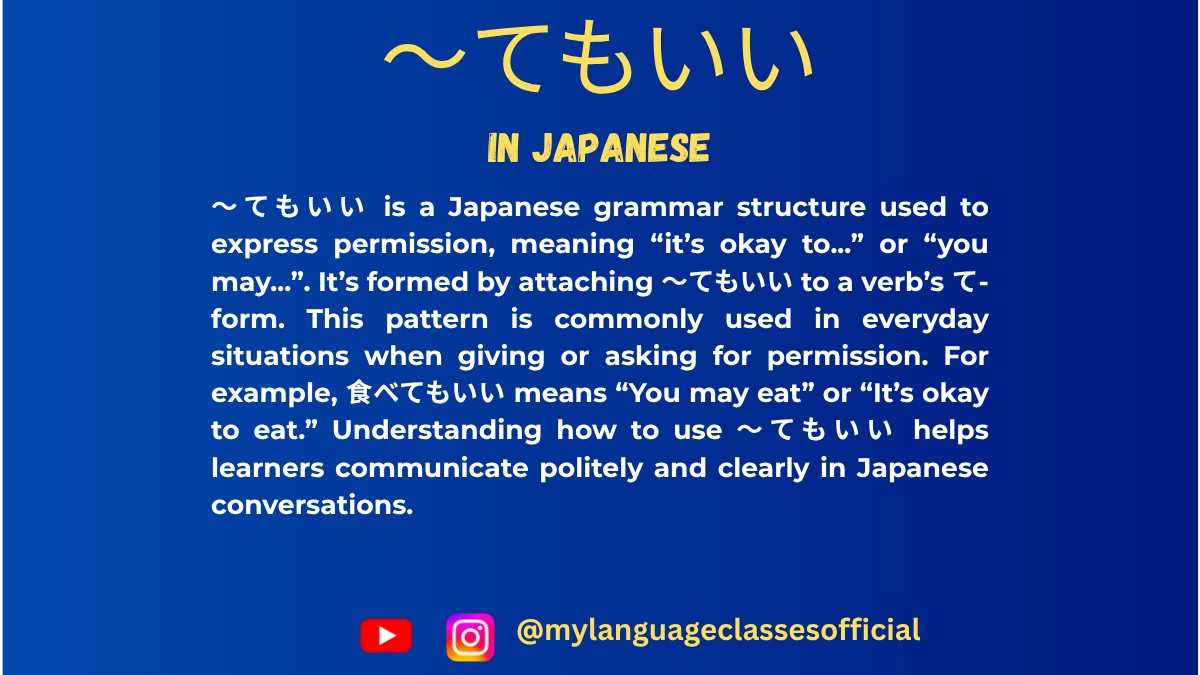Your cart is currently empty!
Tag: world of languages
-

Modal Verbs in Spanish: A Complete Guide
Modal verbs in Spanish, known as verbos modales, are auxiliary verbs that help express necessity, ability, permission, obligation, or possibility. Just like in English, they are followed by an infinitive verb and modify its meaning. Understanding these verbs is essential for mastering Spanish and communicating effectively in daily situations.
Common Modal Verbs in Spanish
Here are the most frequently used modal verbs in Spanish:
- Poder (to be able to, can) – Expresses ability or permission
- Querer (to want, to wish) – Indicates desire or intention
- Deber (must, should, ought to) – Expresses obligation or probability
- Tener que (to have to) – Indicates necessity or obligation
- Haber de (to have to, should) – Expresses mild obligation or intention
- Saber (to know how to) – Expresses ability when used with an infinitive
- Soler (to usually do something) – Describes habitual actions
Usage and Sentence Structures
1. Poder – Expressing Ability and Permission
Conjugation Example (Present Tense):
- Yo puedo
- Tú puedes
- Él/Ella/Usted puede
- Nosotros/Nosotras podemos
- Vosotros/Vosotras podéis
- Ellos/Ellas/Ustedes pueden
Example Sentences:
- Puedo hablar español. (I can speak Spanish.)
- ¿Puedes ayudarme? (Can you help me?)
- No puedes entrar sin permiso. (You cannot enter without permission.)
2. Querer – Expressing Desire or Intention
Conjugation Example (Present Tense):
- Yo quiero
- Tú quieres
- Él/Ella/Usted quiere
- Nosotros/Nosotras queremos
- Vosotros/Vosotras queréis
- Ellos/Ellas/Ustedes quieren
Example Sentences:
- Quiero aprender español. (I want to learn Spanish.)
- ¿Quieres un café? (Do you want a coffee?)
- Ella quiere viajar por el mundo. (She wants to travel around the world.)
3. Deber – Expressing Obligation or Probability
Conjugation Example (Present Tense):
- Yo debo
- Tú debes
- Él/Ella/Usted debe
- Nosotros/Nosotras debemos
- Vosotros/Vosotras debéis
- Ellos/Ellas/Ustedes deben
Example Sentences:
- Debes estudiar más. (You should study more.)
- Debemos respetar a los demás. (We must respect others.)
- Esto debe ser importante. (This must be important.)
4. Tener que – Expressing Necessity
Conjugation Example (Present Tense):
- Yo tengo que
- Tú tienes que
- Él/Ella/Usted tiene que
- Nosotros/Nosotras tenemos que
- Vosotros/Vosotras tenéis que
- Ellos/Ellas/Ustedes tienen que
Example Sentences:
- Tengo que trabajar mañana. (I have to work tomorrow.)
- ¿Tienes que irte ahora? (Do you have to leave now?)
- Ellos tienen que hacer la tarea. (They have to do their homework.)
5. Haber de – Expressing Mild Obligation or Intention
Example Sentences:
- He de llamarte más tarde. (I have to call you later.)
- Has de saber la verdad. (You should know the truth.)
6. Saber – Expressing Ability or Knowledge
Example Sentences:
- Sé nadar muy bien. (I know how to swim very well.)
- ¿Sabes tocar la guitarra? (Do you know how to play the guitar?)
7. Soler – Expressing Habitual Actions
Example Sentences:
- Suelo levantarme temprano. (I usually wake up early.)
- ¿Sueles ir al gimnasio? (Do you usually go to the gym?)
Conjugation and Verb Formation Rules
Regular Verb Conjugation in Present Tense
AR verbs: hablar (to speak)
- Yo hablo
- Tú hablas
- Él/Ella/Usted habla
- Nosotros/Nosotras hablamos
- Vosotros/Vosotras habláis
- Ellos/Ellas/Ustedes hablan
ER verbs: comer (to eat)
- Yo como
- Tú comes
- Él/Ella/Usted come
- Nosotros/Nosotras comemos
- Vosotros/Vosotras coméis
- Ellos/Ellas/Ustedes comen
IR verbs: vivir (to live)
- Yo vivo
- Tú vives
- Él/Ella/Usted vive
- Nosotros/Nosotras vivimos
- Vosotros/Vosotras vivís
- Ellos/Ellas/Ustedes viven
Irregular Modal Verbs Conjugation in Present Tense
Poder (o→ue change)
- Yo puedo
- Tú puedes
- Él/Ella/Usted puede
- Nosotros/Nosotras podemos
- Vosotros/Vosotras podéis
- Ellos/Ellas/Ustedes pueden
Querer (e→ie change)
- Yo quiero
- Tú quieres
- Él/Ella/Usted quiere
- Nosotros/Nosotras queremos
- Vosotros/Vosotras queréis
- Ellos/Ellas/Ustedes quieren
Things to Keep in Mind
- Articles and Gender: Modal verbs are always followed by an infinitive verb, but nouns used in the sentence must agree in gender and number.
- Example: Debes comprar la mesa (You must buy the table – ‘mesa’ is feminine).
- Plurality: Modal verbs do not change based on the plurality of the infinitive verb.
- Example: Puedes comprar los libros (You can buy the books).
- Sentence Structure: Modal verbs follow a Subject + Modal Verb + Infinitive structure.
- Example: Ella quiere bailar (She wants to dance).
Conclusion
Mastering modal verbs in Spanish is crucial for fluency and natural conversation. Whether you’re asking for permission, expressing obligation, or stating an ability, these verbs will help you communicate effectively. Keep practicing their conjugations and use them in real-life situations to improve your Spanish proficiency!
If you enjoyed this lesson, be sure to check out more posts like this on my blog at My Language Classes. Don’t forget to subscribe my YouTube channel and follow me on Instagram for the latest language learning tips and lessons. Leave a comment below to share your thoughts, or ask any questions you have.
Happy learning! 😊
-
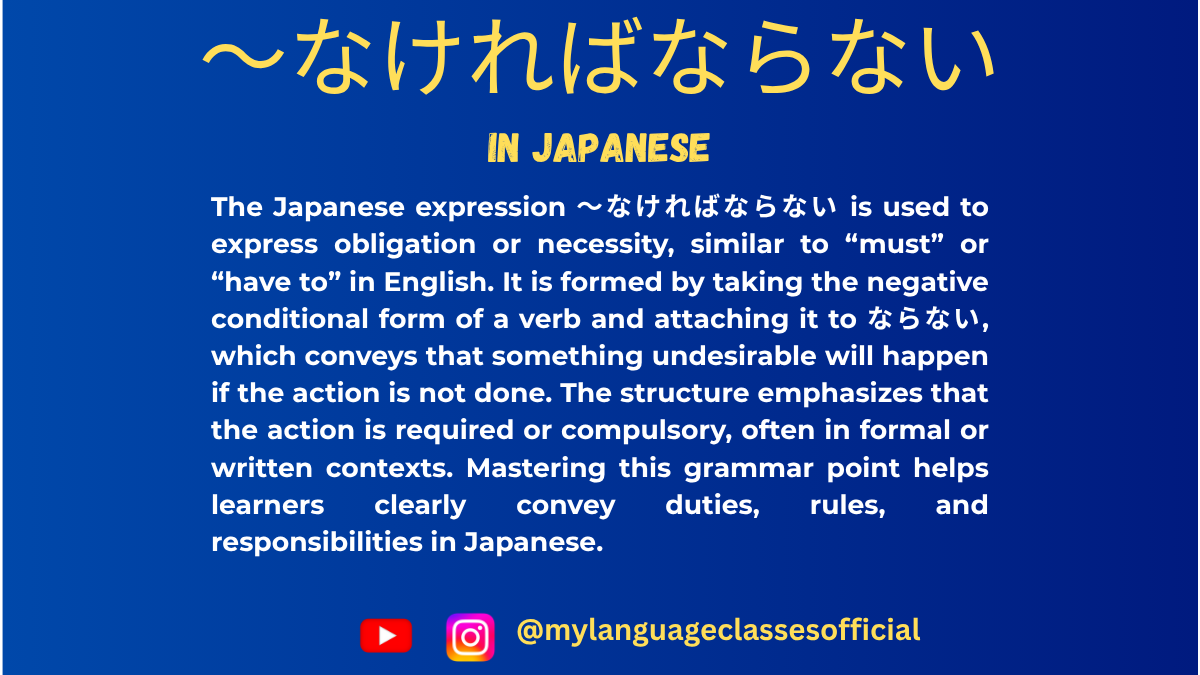
Understanding 〜なければならない in Japanese | My Language Classes
How to Use 〜なければならないin Japanese
The phrase 〜なければならない is a commonly used Japanese grammar structure that expresses obligation or necessity, similar to “must” or “have to” in English. It’s essential for learners to master this phrase because it is frequently used in both formal and casual settings.
Structure of 〜なければならない
- Verb in the Negative Form + なければならない
- Example: 行く → 行かなければならない
(iku → ikanakereba naranai)- Meaning: “I must go.”
- Example: 行く → 行かなければならない
- Conjugation Steps:
- Take the negative form of the verb (ない form).
- Replace ない with なければならない.
Variations of 〜なければならない
- 〜なければいけない
- Another common form with the same meaning.
- Slightly softer in tone.
- 〜なくてはならない
- Less commonly used in casual conversation but often appears in written or formal contexts.
- 〜なくてはいけない
- Similar to 〜なければいけない and used in formal or polite speech.
Situations Where 〜なければならない is Used
Here’s a list of situations where this grammar is appropriate:
1. Rules and Regulations
- Expressing obligations based on rules or laws.
- Example:
- 学校に行かなければならない。
(Gakkou ni ikanakereba naranai.)- Meaning: “I must go to school.”
- 学校に行かなければならない。
2. Work and Responsibilities
- Talking about duties or tasks that must be completed.
- Example:
- 仕事を終わらせなければならない。
(Shigoto o owarasena kereba naranai.)- Meaning: “I must finish the work.”
- 仕事を終わらせなければならない。
3. Social and Cultural Expectations
- Highlighting social norms or obligations.
- Example:
- 礼儀を守らなければならない。
(Reigi o mamorana kereba naranai.)- Meaning: “I must observe proper manners.”
- 礼儀を守らなければならない。
4. Personal Commitments
- Expressing personal resolutions or goals.
- Example:
- ダイエットのために運動しなければならない。
(Daietto no tame ni undou shinakereba naranai.)- Meaning: “I must exercise for my diet.”
- ダイエットのために運動しなければならない。
5. Health and Safety
- Discussing health-related necessities.
- Example:
- 健康のために野菜を食べなければならない。
(Kenkou no tame ni yasai o tabena kereba naranai.)- Meaning: “I must eat vegetables for my health.”
- 健康のために野菜を食べなければならない。
6. Moral or Ethical Obligations
- Talking about what is morally right.
- Example:
- 嘘をついてはいけないし、謝らなければならない。
(Uso o tsuite wa ikenai shi, ayamaranakereba naranai.)- Meaning: “I must not lie, and I must apologize.”
- 嘘をついてはいけないし、謝らなければならない。
7. Deadlines and Time-Sensitive Tasks
- When tasks need to be completed by a specific time.
- Example:
- 今週末までにレポートを提出しなければならない。
(Konshuumatsu made ni repooto o teishutsu shinakereba naranai.)- Meaning: “I must submit the report by this weekend.”
- 今週末までにレポートを提出しなければならない。
Key Points to Remember
- Formality:
- 〜なければならない is slightly more formal than 〜なければいけない. Use it in professional or formal writing.
- Alternative Expressions:
- In casual settings, people often shorten the phrase to 〜なきゃ or 〜なくちゃ.
- Example: 勉強しなきゃいけない (Benkyou shinakya ikenai) = “I must study.”
- In casual settings, people often shorten the phrase to 〜なきゃ or 〜なくちゃ.
- Cultural Context:
- Japanese culture values politeness and rules, so this structure is vital for expressing respect towards societal norms.
- Flexibility:
- While the grammar indicates obligation, tone and context can soften its intensity. For example, “You must” may sound harsh in English, but in Japanese, it’s often a gentle reminder or encouragement.
Practice Exercises
- Convert the following sentences into 〜なければならない form:
- 私は毎日運動する。
- 宿題をする。
- 早く起きる。
- Translate into Japanese:
- I must visit the doctor tomorrow.
- We have to clean the house by this evening.
- Imagine you are living in Japan. Write three sentences about what you “must” do in daily life using 〜なければならない.
Mastering 〜なければならない is crucial for understanding how to express obligations in Japanese effectively. Start using it in your conversations and writing to become more natural and fluent!
If you enjoyed this lesson, be sure to check out more posts like this on my blog at My Language Classes. Don’t forget to subscribe my YouTube channel and follow me on Instagram for the latest language learning tips and lessons. Leave a comment below to share your thoughts, or ask any questions you have about nouns.
Happy learning! 😊
- Verb in the Negative Form + なければならない
-
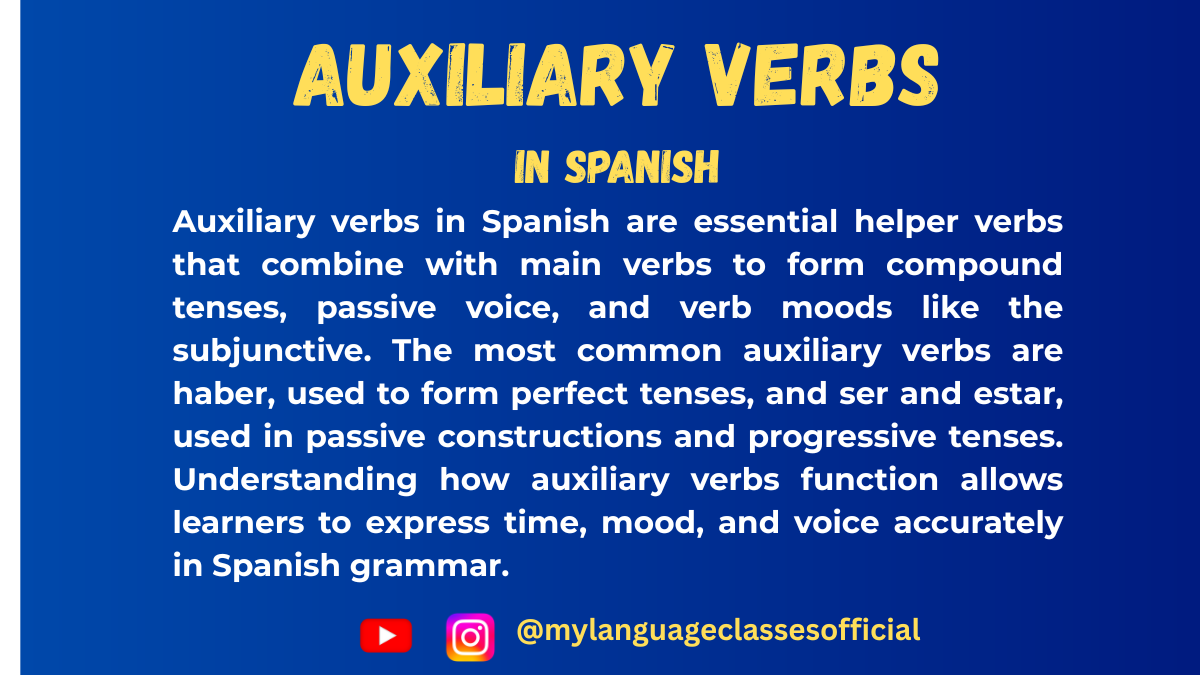
Auxiliary Verbs in Spanish: A Complete Guide
Auxiliary verbs, or “verbos auxiliares” in Spanish, play a crucial role in forming various tenses, moods, and grammatical structures. They are used in conjunction with main verbs to express nuances such as obligation, ability, probability, or temporality. Understanding auxiliary verbs is essential for mastering Spanish fluency.
Common Auxiliary Verbs in Spanish
- Haber (to have – for perfect tenses)
- Ser (to be – for passive voice and descriptions)
- Estar (to be – for progressive tenses and states)
- Tener que (to have to – for obligations)
- Deber (must/should – for necessity and advice)
- Poder (can – for ability and permission)
- Ir a (going to – for future actions)
- Querer (to want – for desires and intentions)
- Soler (to usually – for habitual actions)
1. Haber: Forming Perfect Tenses
Haber is used as an auxiliary verb to form compound tenses like the present perfect, past perfect, and future perfect.
Conjugation of Haber (Present Indicative):
- Yo he
- Tú has
- Él/Ella/Usted ha
- Nosotros/as hemos
- Vosotros/as habéis
- Ellos/Ellas/Ustedes han
Example Sentences:
- Yo he comido hoy. (I have eaten today.)
- ¿Has visto la película? (Have you seen the movie?)
Things to Keep in Mind:
- The past participle always remains unchanged (e.g., comido, visto, escrito).
- Haber must be conjugated in the correct tense and subject agreement.
2. Ser and Estar: Expressing Passive Voice and Progressive Tenses
- Ser is used for the passive voice and permanent characteristics.
- Estar is used for the present progressive tense and temporary conditions.
Conjugation of Ser (Present Indicative):
- Yo soy
- Tú eres
- Él/Ella/Usted es
- Nosotros/as somos
- Vosotros/as sois
- Ellos/Ellas/Ustedes son
Conjugation of Estar (Present Indicative):
- Yo estoy
- Tú estás
- Él/Ella/Usted está
- Nosotros/as estamos
- Vosotros/as estáis
- Ellos/Ellas/Ustedes están
Example Sentences:
- La puerta es cerrada por el profesor. (The door is closed by the teacher.)
- Estoy estudiando español. (I am studying Spanish.)
3. Tener que, Deber, and Poder: Expressing Obligation, Necessity, and Ability
- Tener que + infinitive: Expresses strong obligation.
- Ejemplo: Tengo que trabajar mañana. (I have to work tomorrow.)
- Deber + infinitive: Expresses necessity or recommendation.
- Ejemplo: Debes hacer ejercicio. (You should exercise.)
- Poder + infinitive: Expresses ability or permission.
- Ejemplo: ¿Puedes ayudarme? (Can you help me?)
4. Ir a + Infinitive: Talking About the Near Future
This structure is similar to the English “going to.” It is commonly used in spoken Spanish.
Example Sentences:
- Voy a viajar a España. (I am going to travel to Spain.)
- ¿Vas a llamar a tu madre? (Are you going to call your mother?)
5. Querer and Soler: Expressing Intentions and Habits
- Querer + infinitive: Expresses desire.
- Ejemplo: Quiero aprender español. (I want to learn Spanish.)
- Soler + infinitive: Expresses habitual actions.
- Ejemplo: Suelo leer antes de dormir. (I usually read before sleeping.)
Conjugation of Regular and Irregular Verbs in Auxiliary Verb Constructions
Spanish verbs fall into three categories: -AR, -ER, and -IR verbs.
Regular Verb Conjugation in the Present Participle (Gerundio)
- -AR verbs: hablar → hablando (speaking)
- -ER verbs: comer → comiendo (eating)
- -IR verbs: vivir → viviendo (living)
Past Participle Formation (Used with Haber)
- -AR verbs: hablar → hablado
- -ER verbs: comer → comido
- -IR verbs: vivir → vivido
Irregular Past Participles
- Decir → dicho (said)
- Hacer → hecho (done)
- Ver → visto (seen)
- Escribir → escrito (written)
List of Common Expressions with Auxiliary Verbs
Here are some daily expressions using auxiliary verbs:
- ¿Has comido? (Have you eaten?)
- Voy a salir ahora. (I am going to leave now.)
- Puedes ayudarme, por favor. (Can you help me, please?)
- Debemos estudiar más. (We must study more.)
- Tienes que llamar a tu madre. (You have to call your mother.)
Things to Keep in Mind
- Gender and Plurality: Auxiliary verbs themselves do not change for gender, but past participles used with “ser” must agree in gender and number (e.g., “La tarea fue hecha.”)
- Use of Articles: In general, articles (el, la, los, las) are necessary with nouns but not with infinitive verbs.
- Reflexive Verbs: When using auxiliary verbs with reflexive verbs, place the reflexive pronoun before the auxiliary verb or attach it to the infinitive (e.g., “Me voy a duchar” / “Voy a ducharme”).
Final Thoughts
Mastering auxiliary verbs in Spanish is essential for building more complex sentences and improving fluency. Understanding when and how to use “haber,” “ser,” “estar,” “tener que,” and other auxiliary verbs will help you navigate Spanish conversations with ease. Keep practicing with real-life examples, and soon, using these verbs will become second nature!
¿Quieres seguir aprendiendo? (Do you want to keep learning?) Stay tuned for more Spanish lessons!
If you enjoyed this lesson, be sure to check out more posts like this on my blog at My Language Classes. Don’t forget to subscribe my YouTube channel and follow me on Instagram for the latest language learning tips and lessons. Leave a comment below to share your thoughts, or ask any questions you have.
Happy learning! 😊
-
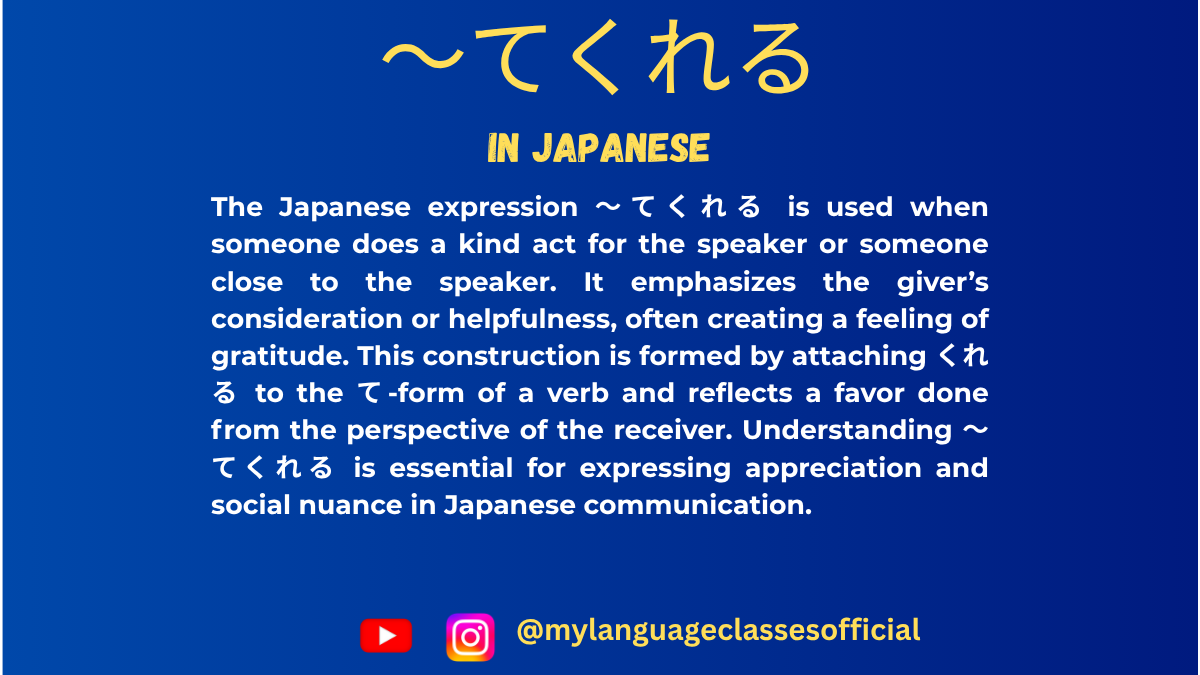
How to Use 〜てくれる | My Language Classes
Understanding “〜てくれる” in Japanese
The Japanese expression 〜てくれる is a key grammatical structure used to describe actions done for the speaker’s benefit or someone close to them. It conveys gratitude and appreciation towards the doer. Let’s explore its usage in various contexts and provide a list of situations where “〜てくれる” is used.
What is 〜てくれる?
“〜てくれる” is derived from the verb くれる, which means “to give.” When attached to the て-form of a verb, it expresses that someone performs an action for the speaker (or someone in the speaker’s inner circle). It implies a sense of appreciation and goodwill.
- Structure:
[Person] が [Verb (て-form)] くれる
(Someone does something for me or someone in my group.) - Example:
- 友達が宿題を手伝ってくれた。
(Tomodachi ga shukudai o tetsudatte kureta.)
→ “My friend helped me with my homework.” - 先生が日本語を教えてくれました。
(Sensei ga Nihongo o oshiete kuremashita.)
→ “The teacher kindly taught me Japanese.”
- 友達が宿題を手伝ってくれた。
Situations Where 〜てくれる is Used
1. When Someone Helps You
Used when someone provides assistance that benefits the speaker.
- Example:
- 兄が荷物を運んでくれた。 (Ani ga nimotsu o hakonde kureta.)
→ “My older brother carried my luggage for me.”
- 兄が荷物を運んでくれた。 (Ani ga nimotsu o hakonde kureta.)
2. When Someone Gives You Something
Used when someone gives you an object (related to くれる itself).
- Example:
- 友達がプレゼントを買ってくれた。 (Tomodachi ga purezento o katte kureta.)
→ “My friend bought me a present.”
- 友達がプレゼントを買ってくれた。 (Tomodachi ga purezento o katte kureta.)
3. When Someone Does a Favor for You
Used when someone voluntarily does something kind.
- Example:
- 彼が傘を貸してくれた。 (Kare ga kasa o kashite kureta.)
→ “He lent me an umbrella.”
- 彼が傘を貸してくれた。 (Kare ga kasa o kashite kureta.)
4. When Someone Teaches or Instructs You
Used when someone imparts knowledge or skills.
- Example:
- 先生が漢字の書き方を教えてくれた。 (Sensei ga kanji no kakikata o oshiete kureta.)
→ “The teacher taught me how to write kanji.”
- 先生が漢字の書き方を教えてくれた。 (Sensei ga kanji no kakikata o oshiete kureta.)
5. When Someone Listens to You
Used when someone listens or gives attention to you.
- Example:
- 友達が悩みを聞いてくれた。 (Tomodachi ga nayami o kiite kureta.)
→ “My friend listened to my worries.”
- 友達が悩みを聞いてくれた。 (Tomodachi ga nayami o kiite kureta.)
6. When Someone Accompanies You
Used when someone goes with you somewhere.
- Example:
- 母が病院まで一緒に行ってくれた。 (Haha ga byouin made issho ni itte kureta.)
→ “My mother went to the hospital with me.”
- 母が病院まで一緒に行ってくれた。 (Haha ga byouin made issho ni itte kureta.)
7. When Someone Encourages or Supports You
Used when someone gives encouragement.
- Example:
- 彼が試験の前に励ましてくれた。 (Kare ga shiken no mae ni hagemashite kureta.)
→ “He encouraged me before the exam.”
- 彼が試験の前に励ましてくれた。 (Kare ga shiken no mae ni hagemashite kureta.)
8. When Someone Waits for You
Used when someone waits patiently for you.
- Example:
- 友達が駅で待ってくれた。 (Tomodachi ga eki de matte kureta.)
→ “My friend waited for me at the station.”
- 友達が駅で待ってくれた。 (Tomodachi ga eki de matte kureta.)
9. When Someone Fixes or Repairs Something for You
Used when someone fixes something for your benefit.
- Example:
- 父が自転車を直してくれた。 (Chichi ga jitensha o naoshite kureta.)
→ “My father fixed my bicycle.”
- 父が自転車を直してくれた。 (Chichi ga jitensha o naoshite kureta.)
10. When Someone Invites You or Gives You a Treat
Used when someone invites or pays for you.
- Example:
- 彼がコーヒーをおごってくれた。 (Kare ga koohii o ogotte kureta.)
→ “He treated me to coffee.”
- 彼がコーヒーをおごってくれた。 (Kare ga koohii o ogotte kureta.)
Notes on Usage
- Subject Consideration:
- The giver of the action is the grammatical subject, not the receiver.
- Example:
- 彼がケーキを作ってくれた。 (He made a cake for me.)
- 私にケーキを作ってくれた is unnatural (omit 私に).
- Politeness Levels:
- Casual: 〜てくれる
- Polite: 〜てくれます
- Past polite: 〜てくれました
- Not Used for Superior-to-Subordinate Actions:
- You cannot use 〜てくれる when a subordinate (like a junior worker) does something for a superior (like a boss). Instead, use 〜てくださいました (keigo).
Conclusion
The expression 〜てくれる is an essential part of Japanese communication, showing gratitude when someone does something beneficial for the speaker. By understanding the different contexts in which it is used, learners can express appreciation naturally and appropriately in Japanese conversations.
Do you have any questions about 〜てくれる? Let me know in the comments! 😊
If you enjoyed this lesson, be sure to check out more posts like this on my blog at My Language Classes. Don’t forget to subscribe my YouTube channel and follow me on Instagram for the latest language learning tips and lessons. Leave a comment below to share your thoughts, or ask any questions you have about nouns.
Happy learning! 😊
- Structure:
-
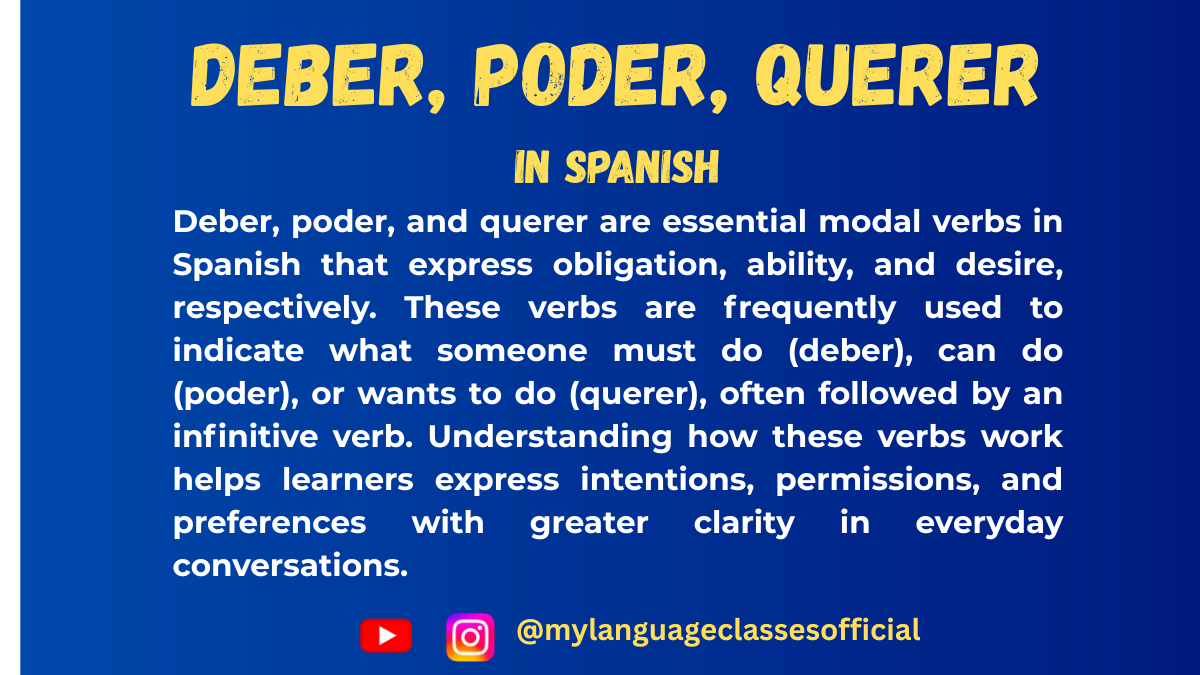
Deber, Poder, Querer: Expressing Obligation, Possibility, and Desire in Spanish
In Spanish, the verbs deber, poder, and querer are commonly used to express obligation, possibility, and desire, respectively. Understanding how to use these verbs correctly is essential for fluent communication. In this blog post, we will explore their meanings, conjugations, and common expressions used in daily life.
1. Deber – Expressing Obligation
The verb deber translates to “must” or “should” in English and is used to indicate duty, necessity, or moral obligation.
Common Expressions with Deber
- Deber + infinitivo → “Must/should do something.”
- Debo estudiar para el examen. (I must study for the exam.)
- Debes comer más verduras. (You should eat more vegetables.)
- Deber de + infinitivo → Expresses probability or supposition.
- Debe de estar en casa. (He/She must be at home.)
Conjugation of Deber
Tense Conjugation Present Indicative debo, debes, debe, debemos, debéis, deben Preterite debí, debiste, debió, debimos, debisteis, debieron Imperfect debía, debías, debía, debíamos, debíais, debían Present Subjunctive deba, debas, deba, debamos, debáis, deban Imperative (no direct affirmative imperative; use subjunctive)
2. Poder – Expressing Possibility and Ability
The verb poder means “can” or “to be able to.” It is used to express ability, permission, or possibility.
Common Expressions with Poder
- Poder + infinitivo → “To be able to do something.”
- Puedo nadar bien. (I can swim well.)
- No puedes entrar sin permiso. (You can’t enter without permission.)
- ¿Se puede…? → Asking for permission.
- ¿Se puede fumar aquí? (Can one smoke here?)
- No poder más → “To be unable to handle something anymore.”
- No puedo más con este calor. (I can’t take this heat anymore.)
Conjugation of Poder (Irregular Verb)
Tense Conjugation Present Indicative puedo, puedes, puede, podemos, podéis, pueden Preterite pude, pudiste, pudo, pudimos, pudisteis, pudieron Imperfect podía, podías, podía, podíamos, podíais, podían Present Subjunctive pueda, puedas, pueda, podamos, podáis, puedan Imperative (no direct affirmative imperative; use subjunctive)
3. Querer – Expressing Desire and Intentions
The verb querer means “to want” or “to love.” It is used to express desires, wishes, and sometimes affection.
Common Expressions with Querer
- Querer + infinitivo → “To want to do something.”
- Quiero viajar a España. (I want to travel to Spain.)
- ¿Quieres salir esta noche? (Do you want to go out tonight?)
- Querer a alguien → “To love someone.”
- Te quiero mucho. (I love you a lot.)
- Querer decir → “To mean.”
- ¿Qué quiere decir esta palabra? (What does this word mean?)
Conjugation of Querer (Irregular Verb)
Tense Conjugation Present Indicative quiero, quieres, quiere, queremos, queréis, quieren Preterite quise, quisiste, quiso, quisimos, quisisteis, quisieron Imperfect quería, querías, quería, queríamos, queríais, querían Present Subjunctive quiera, quieras, quiera, queramos, queráis, quieran Imperative (no direct affirmative imperative; use subjunctive)
Key Considerations When Using Deber, Poder, Querer
- Articles and Gender:
- Use el, la, los, las with nouns when necessary.
- Example: Debes respetar las reglas. (You must respect the rules.)
- Plural vs. Singular:
- Conjugate the verb based on the subject.
- Example: Ellos pueden hablar inglés. (They can speak English.)
- Using the Subjunctive:
- Often follows expressions of doubt, wishes, or hypothetical scenarios.
- Example: Quiero que vengas conmigo. (I want you to come with me.)
- Negation:
- Use “no” before the verb to make it negative.
- Example: No debes mentir. (You must not lie.)
Conclusion
Mastering deber, poder, and querer is essential for effective communication in Spanish. These verbs allow you to express obligation, possibility, and desire in various situations. By understanding their conjugations, common expressions, and proper grammatical usage, you will significantly enhance your Spanish fluency. Keep practicing, and soon, you’ll be able to use them naturally in conversations!
If you enjoyed this lesson, be sure to check out more posts like this on my blog at My Language Classes. Don’t forget to subscribe my YouTube channel and follow me on Instagram for the latest language learning tips and lessons. Leave a comment below to share your thoughts, or ask any questions you have.
Happy learning! 😊
- Deber + infinitivo → “Must/should do something.”
-

How to Use 〜てもらう | My Language Classes
The Japanese Grammar 〜てもらう
The Japanese grammar pattern 〜てもらう is an essential structure used to express receiving a favor from someone. It emphasizes that someone is doing something beneficial for the speaker or a third party. Understanding this grammar is crucial for natural and polite Japanese communication.
This post will explain 〜てもらう in various situations, provide example sentences, and list common contexts where it is used.
Structure of 〜てもらう
The pattern follows this structure:
Person A (receiver) + は/が + Person B (doer) + に + Verb in 〜て form + もらう
- A is the person who benefits from the action.
- B is the person performing the action for A.
- The verb is conjugated into the て-form and followed by もらう (to receive).
Example:
- 私は先生に日本語を教えてもらいました。
(I had my teacher teach me Japanese.)
Difference Between 〜てもらう and 〜てあげる
- 〜てもらう: Focuses on the receiver of the favor.
- 〜てあげる: Focuses on the giver of the favor.
Example:
- 私は先生に日本語を教えてもらいました。 (I received Japanese lessons from my teacher.)
- 私は先生に日本語を教えてあげました。 (I taught Japanese to my teacher.)
Various Situations Where 〜てもらう Is Used
1. Receiving Help
When someone helps you with a task or does something for your benefit.
Example:
- 私は彼氏に財実を送ってもらいました。
(I had my boyfriend send my wallet.)
2. Receiving Permission
Used when asking for permission to do something.
Example:
- 先生にはやく帰らせてもらいました。
(I got permission from my teacher to leave early.)
3. Receiving a Favor Indirectly
You receive a favor, but a third party performs the action.
Example:
- 母は先生にむすこの学校の事を説明してもらいました。
(My mother had the teacher explain about the school to her.)
4. Making Polite Requests
When requesting someone to do something politely.
Example:
- この文章を正しく直してもらえますか。
(Could you please correct this text for me?)
5. Receiving Information
When someone shares knowledge or guidance.
Example:
- 先生にいろいろな情報を教えてもらいました。
(I received a lot of information from my teacher.)
6. Asking for Medical Assistance
Used when getting treatment or medical help from someone.
Example:
- 医者に病治をしてもらいました。
(I got treated by the doctor.)
7. Receiving a Physical Object
Used when someone gives you something.
Example:
- 友人に好きな本を買ってもらいました。
(My friend bought me a book I like.)
8. Receiving Guidance or Instructions
Used when someone teaches you or gives instructions.
Example:
- 先生に作文の書き方を教えてもらいました。
(I had my teacher teach me how to write essays.)
Summary of Situations Where 〜てもらう Is Used
Here’s a quick reference list:
- Receiving help (task-related support)
- Receiving permission
- Receiving a favor indirectly
- Making polite requests
- Receiving information or knowledge
- Asking for medical assistance
- Receiving a physical object
- Receiving guidance or instructions
Conclusion
〜てもらう is a crucial grammar point in Japanese, allowing you to express receiving favors, help, or benefits from others. Mastering this structure enhances your ability to communicate politely and effectively in various situations. Practice using it in conversations to improve fluency and comprehension!
If you enjoyed this lesson, be sure to check out more posts like this on my blog at My Language Classes. Don’t forget to subscribe my YouTube channel and follow me on Instagram for the latest language learning tips and lessons. Leave a comment below to share your thoughts, or ask any questions you have about nouns.
Happy learning! 😊

